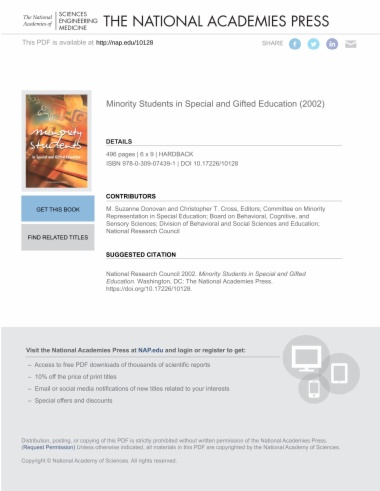Special education and gifted and talented programs were designed for children whose educational needs are not well met in regular classrooms. From their inceptions, these programs have had disproportionate representation of racial and ethnic minority students. What causes this disproportion? Is it a problem?
Minority Students in Special and Gifted Education considers possible contributors to that disparity, including early biological and environmental influences and inequities in opportunities for preschool and K-12 education, as well as the possibilities of bias in the referral and assessment system that leads to placement in special programs. It examines the data on early childhood experience, on differences in educational opportunity, and on referral and placement.
The book also considers whether disproportionate representation should be considered a problem. Do special education programs provide valuable educational services, or do they set students off on a path of lower educational expectations? Would students not now placed in gifted and talented programs benefit from raised expectations, more rigorous classes, and the gifted label, or would they suffer failure in classes for which they are unprepared?
By examining this important problem in U.S. education and making recommendations for early intervention and general education, as well as for changes in referral and assessment processes, Minority Students in Special and Gifted Education will be an indispensable resource to educators throughout the nation, as well as to policy makers at all levels, from schools and school districts to the state and federal governments.
- Cover
- Front Matter
- Executive Summary
- 1 The Context of Special and Gifted Education
- 2 Representation of Minority Students in Special and Gifted Education
- 3 Influences on Cognitive and Behavioral Development
- 4 Early Intervention Programs
- 5 The General Education Context
- 6 The Legal Context and the Referral Process
- 7 Assessment Practices, Definitions, and Classification Criteria
- 8 Alternative Approaches to Assessment
- 9 Weighing the Benefits of Placement
- 10 Recommendations
- References
- Biographical Sketches
- Index

